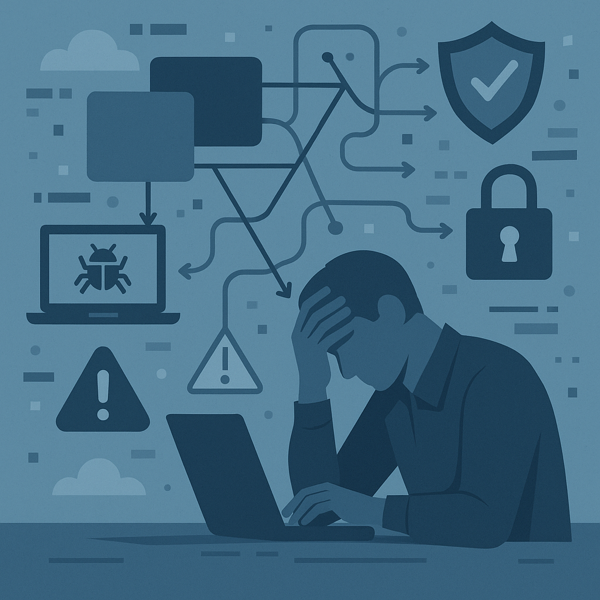Security teams don’t burn out because of “too many threats.” They burn out because of too much junk between them and the real threats: noisy detections, vague alerts, fragile rules, and AI that promises magic but ships mayhem.

Here’s a simple fix that works in the real world: treat alert quality like a reliability objective. Put noise on a hard budget and enforce a ship/rollback gate—exactly like SRE error budgets. We call it an Alert-Quality SLO (AQ-SLO) and it can reclaim 20–40% of analyst time for higher-value work like hunts, tuning, and purple-team exercises.
The Core Idea: Put a Budget on Junk
Alert-Quality SLO (AQ-SLO): set an explicit ceiling for non-actionable alerts per analyst-hour (NAAH). If a new rule/model/AI feed pushes you over budget, it doesn’t ship—or it auto-rolls back.
Think “error budgets,” but applied to SOC signal quality.
Working definitions (plain language)
- Non-actionable alert: After triage, it requires no ticket, containment, or tuning request—just closes.
- Analyst-hour: One hour of human triage time (any level).
- AQ-SLO: Maximum tolerated non-actionables per analyst-hour over a rolling window.
Baselines and Targets (Start Here)
Before you tune, measure. Collect 2–4 weeks of baselines:
- Non-actionable rate (NAR) = (Non-actionables / Total alerts) × 100
- Non-actionables per analyst-hour (NAAH) = Non-actionables / Analyst-hours
- Mean time to triage (MTTT) = Average minutes to disposition (track P90, too)
Initial SLO targets (adjust to your environment):
- NAAH ≤ 5.0 (Gold ≤ 3.0, Silver ≤ 5.0, Bronze ≤ 7.0)
- NAR ≤ 35% (Gold ≤ 20%, Silver ≤ 35%, Bronze ≤ 45%)
- MTTT ≤ 6 min (with P90 ≤ 12 min)
These numbers are intentionally pragmatic: tight enough to curb fatigue, loose enough to avoid false heroics.
Ship/Rollback Gate for Rules & AI
Every new detector—rule, correlation, enrichment, or AI model—must prove itself in shadow mode before it’s allowed to page humans.
Shadow-mode acceptance (7 days recommended):
- NAAH ≤ 3.0, or
- ≥ 30% precision uplift vs. control, and
- No regression in P90 MTTT or paging load
Enforcement: If the detector breaches the budget 3 days in 7, auto-disable or revert and capture a short post-mortem. You’re not punishing innovation—you’re defending analyst attention.
Minimum Viable Telemetry (Keep It Simple)
For every alert, capture:
- detector_id
- created_at
- triage_outcome → {actionable | non_actionable}
- triage_minutes
- root_cause_tag → {tuning_needed, duplicate, asset_misclass, enrichment_gap, model_hallucination, rule_overlap}
Hourly roll-ups to your dashboard:
- NAAH, NAR, MTTT (avg & P90)
- Top 10 noisiest detectors by non-actionable volume and triage cost
This is enough to run the whole AQ-SLO loop without building a data lake first.
Operating Rhythm (SOC-wide, 45 Minutes/Week)
- Noise Review (20 min): Examine the Top 10 noisiest detectors → keep, fix, or kill.
- Tuning Queue (15 min): Assign PRs/changes for the 3 biggest contributors; set owners and due dates.
- Retro (10 min): Are we inside the budget? If not, apply the rollback rule. No exceptions.
Make it boring, repeatable, and visible. Tie it to team KPIs and vendor SLAs.
What to Measure per Detector/Model
- Precision @ triage = actionable / total
- NAAH contribution = non-actionables from this detector / analyst-hours
- Triage cost = Σ triage_minutes
- Kill-switch score = weighted blend of (precision↓, NAAH↑, triage cost↑)
Rank detectors by kill-switch score to drive your weekly agenda.
Formulas You Can Drop into a Sheet
NAAH = NON_ACTIONABLE_COUNT / ANALYST_HOURS
NAR% = (NON_ACTIONABLE_COUNT / TOTAL_ALERTS) * 100
MTTT = AVERAGE(TRIAGE_MINUTES)
MTTT_P90 = PERCENTILE(TRIAGE_MINUTES, 0.9)
ERROR_BUDGET_USED = max(0, (NAAH – SLO_NAAH) / SLO_NAAH)
These translate cleanly into Grafana, Kibana/ELK, BigQuery, or a simple spreadsheet.
Fast Implementation Plan (14 Days)
Day 1–3: Instrument triage outcomes and minutes in your case system. Add the root-cause tags above.
Day 4–10: Run all changes in shadow mode. Publish hourly NAAH/NAR/MTTT to a single dashboard.
Day 11: Freeze SLOs (start with ≤ 5 NAAH, ≤ 35% NAR).
Day 12–14: Turn on auto-rollback for any detector breaching budget.
If your platform supports feature flags, wrap detectors with a kill-switch. If not, document a manual rollback path and make it muscle memory.
SOC-Wide Incentives (Make It Stick)
- Team KPI: % of days inside AQ-SLO (target ≥ 90%).
- Engineering KPI: Time-to-fix for top noisy detectors (target ≤ 5 business days).
- Vendor/Model SLA: Noise clauses—breach of AQ-SLO triggers fee credits or disablement.
This aligns incentives across analysts, engineers, and vendors—and keeps the pager honest.
Why AQ-SLOs Work (In Practice)
- Cuts alert fatigue and stabilizes on-call burdens.
- Reclaims 20–40% analyst time for hunts, purple-team work, and real incident response.
- Turns AI from hype to reliability: shadow-mode proof + rollback by budget makes “AI in the SOC” shippable.
- Improves organizational trust: leadership gets clear, comparable metrics for signal quality and human cost.
Common Pitfalls (and How to Avoid Them)
- Chasing zero noise. You’ll starve detection coverage. Use realistic SLOs and iterate.
- No root-cause tags. You can’t fix what you can’t name. Keep the tag set small and enforced.
- Permissive shadow-mode. If it never ends, it’s not a gate. Time-box it and require uplift.
- Skipping rollbacks. If you won’t revert noisy changes, your SLO is a wish, not a control.
- Dashboard sprawl. One panel with NAAH, NAR, MTTT, and the Top 10 noisiest detectors is enough.
Policy Addendum (Drop-In Language You Can Adopt Today)
Alert-Quality SLO: The SOC shall maintain non-actionable alerts ≤ 5 per analyst-hour on a 14-day rolling window. New detectors (rules, models, enrichments) must pass a 7-day shadow-mode trial demonstrating NAAH ≤ 3 or ≥ 30% precision uplift with no P90 MTTT regressions. Detectors that breach the SLO on 3 of 7 days shall be disabled or rolled back pending tuning. Weekly noise-review and tuning queues are mandatory, with owners and due dates tracked in the case system.
Tune the numbers to fit your scale and risk tolerance, but keep the mechanics intact.
What This Looks Like in the SOC
- An engineer proposes a new AI phishing detector.
- It runs in shadow mode for 7 days, with precision measured at triage and NAAH tracked hourly.
- It shows a 36% precision uplift vs. the current phishing rule set and no MTTT regression.
- It ships behind a feature flag tied to the AQ-SLO budget.
- Three days later, a vendor feed change spikes duplicate alerts. The budget breaches.
- The feature flag kills the noisy path automatically, a ticket captures the post-mortem, and the tuning PR lands in 48 hours.
- Analyst pager load stays stable; hunts continue on schedule.
That’s what operationalized AI looks like when noise is a first-class reliability concern.
Want Help Standing This Up?
MicroSolved has implemented AQ-SLOs and ship/rollback gates in SOCs of all sizes—from credit unions to automotive suppliers—across SIEMs, EDR/XDR, and AI-assisted detection stacks. We can help you:
- Baseline your current noise profile (NAAH/NAR/MTTT)
- Design your shadow-mode trials and acceptance gates
- Build the dashboard and auto-rollback workflow
- Align SLAs, KPIs, and vendor contracts to AQ-SLOs
- Train your team to run the weekly operating rhythm
Get in touch: Visit microsolved.com/contact or email info@microsolved.com to talk with our team about piloting AQ-SLOs in your environment.
* AI tools were used as a research assistant for this content, but human moderation and writing are also included. The included images are AI-generated.








